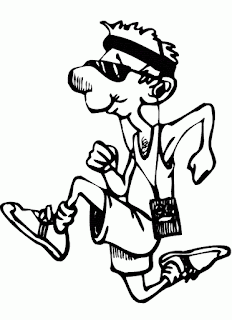5.07.2012
Nimble Neurons
I go to the gym every day. Previously, I went for a long run. The bones do weary. So now it is the gym. It is also warmer.
I started to exercise in the early 80s, wasn’t sleeping well, too much work. Running was said to improve sleep. At first, I could barely run around the block. Eventually, I ran for miles, in the rain and snow. It was hard sometimes to get out the door. But I always felt better when I did. Who does not want to feel better? For a while it became a bit of an addiction, a positive one, I told myself.
I also accomplished something. Maybe that was it. But I was also fitter, sleeker, in a better mood. It was the beginning of the great running boom, the days of Billy Rogers and Frank Shorter and much talk about the benefits of aerobics.
Later Alberto Salazar became of the great marathon runners. I admired his remarkable ability to ignore pain. When he visited Portland, he used to run up in the hills where I lived then. What a beautiful run as it curved around the crest of the hill! I can still recall every rut in the road, every change of temperature, every easy and tough grade. One day he was out running when I was. I saw him in the distance. I ran faster and faster. Eventually, I reached him. And passed him! We were going in opposite directions.
When I began running, I wasn’t trying to live longer, loose weight, improve my cardiovascular function, avoid the dread disease of old age, or increase my brain volume. Since then each of these effects has been well documented.
Gretchen Reynolds reviews some of this research in a recent article in the Times. She calls exercise “the relationship.” She begins with a study of four groups of mice that were placed in distinct living situations:
1. An enriched environment with toys, abundant food, colorful visual stimuli
2. The same enriched environment plus a set of running wheels in their cage
3. The standard mouse environment—no extra stimulation or running wheels
4. Running wheels alone in the standard mouse environment
Both before and after they were placed in these environments for “several months,” the mice were given a series of “cognitive tests.” The only groups that improved were the two with access to running wheels; the enriched stimulation by itself had no effect on the test performance. Physical activity also led to “healthier brains.”
Do comparable results occur for human exercisers? Two recent studies confirm the animal findings. Both examined the normal loss of brain tissue as a person ages. In one this loss was significantly less in a group of 55 and older individuals with superior cardiovascular function. The authors attributed this outcome to exercise, although they did not have an independent measure of it.
The second study directly measured activity in a group of 60-79 aged individuals who were randomly assigned to an aerobic training group. This consisted of three 1-hour exercise sessions per week for a 6-month period. The nonaerobic group participated in a series of stretching and “toning” sessions during the same 6-month period.
Brain volume increased significantly for the older adults who participated in the aerobic fitness training sessions but not for those who were in the nonaerobic group. Again, physical activity appeared to benefit your brain, as well as your heart. What is true for the mouse is true for the man.
Exercise seems to be good for our smarts and our neurons. So throw away those crossword and Sudoku puzzles and go for a swim, walk, bike ride, or run. You’ll be healthier, feel better, loose some weight, and power-up your brain.
References
Stanley Colcombe et. al. Aerobic fitness reduces brain tissue loss in aging humans. Journal of Gerontology, 2003, 176-180.
Stanley Colcombe et. al. Aerobic exercise training increases brain volume in aging humans. Journal of Gerontology, 2006, 1166-1170
Subscribe to:
Post Comments (Atom)



No comments:
Post a Comment